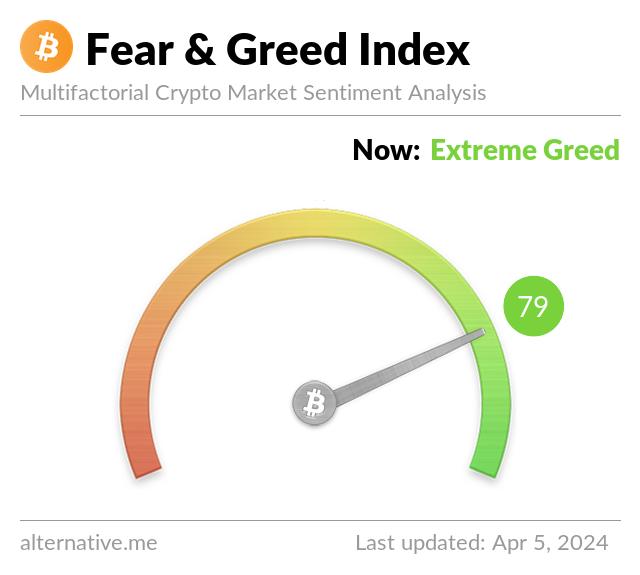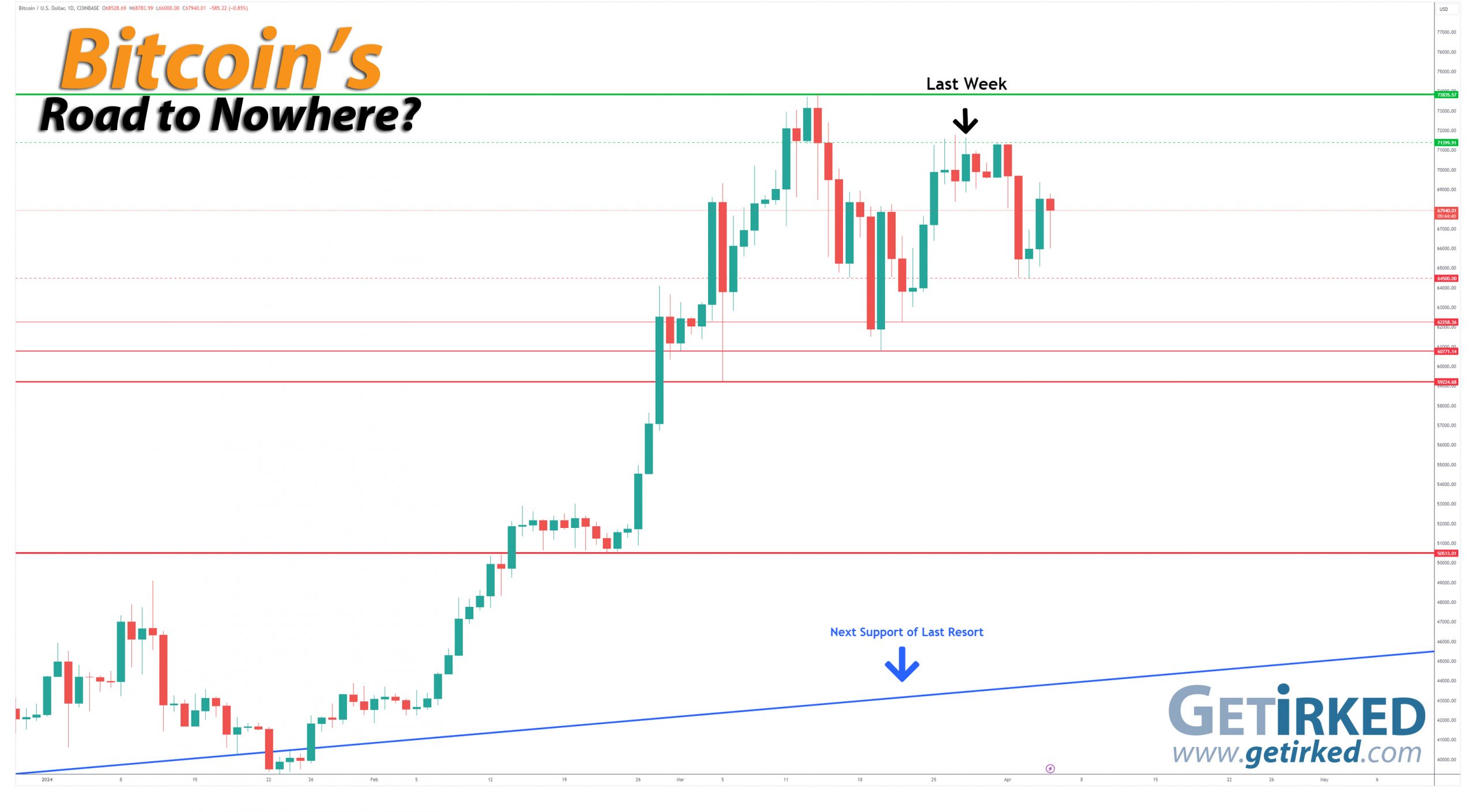Summing Up The Week
Despite PCE coming in hot last Friday, the markets didn’t really react until the treasury rates and international currencies got a little wonky on Tuesday. However, markets shook it off, and, by Thursday, the bulls had regained control… or so it seemed.
Suddenly, in mid-day trading Thursday, the markets rolled over with the S&P 500 closing down -1.23% and the Nasdaq closing down -1.40%. Then, we got Friday’s jobs numbers and the brief pullback was completely forgotten.
Let’s take a look at the news that moved the markets this week…
Market News
PCE rose 2.8% YoY in February, as expected
Last Friday, the personal consumption expenditures (PCE) index showed inflation increased 2.8% on a 12-month basis, up 0.3% from January, and matched estimates, reported CNBC. The PCE remains the Federal Reserve’s preferred gauge of inflation, and, since CPI had come in hot earlier in the month, pundits were expecting similar results from PCE.
While the markets weren’t open due to the Good Friday holiday, it’s hard to say they would react to these results as they were exactly what investors had been anticipating. “Nothing really super surprising. Obviously not the numbers the Fed wants to see, but I don’t think this is going to catch anybody off guard when they come back to work on Monday,” Victoria Greene, chief investment officer at G Squared Private Wealth, told CNBC. “I think everybody is going to pivot to labor pretty quickly and say well maybe if we see some weakness and cracks over here, this little stickiness in inflation and PCE isn’t going to matter as much.”
Powell emphasizes need for more evidence of inflation easing
On Wednesday, Federal Reserve Chairman Jerome Powell once again emphasized the need for more evidence of inflation before the Fed cuts interest rates during a speaking engagement at Stanford University, reported CNBC. “On inflation, it is too soon to say whether the recent readings represent more than just a bump,” Powell said in remarks ahead of a question-and-answer session at Stanford University.
I wonder if Powell feels like a broken record, given that no matter how many times he reiterates this same point, the markets ignore him. “We do not expect that it will be appropriate to lower our policy rate until we have greater confidence that inflation is moving sustainably down toward 2 percent,” he added. “Given the strength of the economy and progress on inflation so far, we have time to let the incoming data guide our decisions on policy.”
Despite his obviously hawkish tone, the S&P 500 still finished up on the day.
Nonfarm Payrolls blow away expectations
On Friday, nonfarm payrolls increased 303,000 versus Dow Jones estimates for just 200,000, reported CNBC. The unemployment rate came in at 3.8% – which was economists expected – so the markets forgot anything that happened during Thursday’s sudden turnaround and went back to rallying.
“This is another really strong report,” said Lauren Goodwin, economist and chief market strategist at New York Life Investments. “This report and the February report showed some broadening in terms of job creation, which is a very good sign.”
Next Week’s Gameplan
Next week’s big event is Wednesday’s Consumer Price Index (CPI), and it truly will be a pivotal catalyst. After two months’ worth of higher-than-expected reports, a third month – especially if CPI is particularly hot – would potentially cinch the idea that inflation has come back and/or remains stickier than most analysts expect.
We also get the Producer Price Index (PPI) on Thursday. While not as market-moving as the CPI, typically, if both reports align with their messaging, they’re likely to move the market one way or another.
As always, have your buying and selling plans ready, and I’ll see you back here next Friday, friends!
This Week in Play
Stay tuned for this week’s episodes of my two portfolios Investments in Play and Speculation in Play coming online later this weekend!
Crytpo Corner

Bitcoin Price (in USD)
%
Weekly Change
Bitcoin Price Action
What happens to Bitcoin after 7 green candles?
Last Sunday, something happened in Bitcoin that’s never happened before, the biggest crypto completed seven (7) consecutive green months in a row. Looking over past bull markets, there has never been a time where Bitcoin closed green seven months in a row, however there have been five and six.
Let’s see what happened:
- 2013: 6 green months followed by a -75.71% pullback in 91 days.
- 2017: 5 green months followed by a -37.63% pullback over 31 days.
- 2019: 5 green months followed by a -53.06% pullback over 153 days (this does not when include the -81.97% drawdown from June 2019 to March 2020’s Black Swan Event).
- 2021: 6 green months followed by a -55.93% pullback over 92 days.
There’s no guarantee anything like this will happen this time, but history rhymes. It’s all worth noting that all four of the above scenarios didn’t occur in a crypto winter; they happened throughout the course of a Bull Market Cycle for Bitcoin!
PLEASE NOTE: These scenarios are not a reason for fear. They’re the reason to make sure you have a buying plan. As always, my approach is to prepare for all possible scenarios in Bitcoin (including it going to zero) and designing a plan – in advance – to account for any outcome.
The Bullish Case
Bulls believe the bounce Bitcoin saw on Thursday could be an indication that the selling is done. The inflows into the Bitcoin ETFs have been positively massive… even during the recent drawdown there inflows not outflows. If demand maintains, the upside potential is very much there as the sellers become exhausted.
The Bearish Case
While Bears acknowledge the near-insatiable demand for Bitcoin – both spot and through the ETFs – Bears make the legitimate argument that the buyers could become exhausted. With so many new investors in the space, Bears argue that one could -20% drawdown in Bitcoin – typically, a very common occurrence in crypto – could be enough to shake the weak hands out and create a selling cascade.
Bitcoin Trade Update
Current Allocation: 2.467% (+21.35% since Last Update)
Current Per-Coin Price: $68,619.29 (-1.83% since Last Update)
Current Profit/Loss Status: -0.99% (-2.49% since Last Update)
When Bitcoin rallied into the end of the quarter, I took that as an incredibly bearish sign and substantially reduced my exposure.
I made a total of 20 separate sale orders which left me with an average selling price of $70,591.56 (after fees). The sales lowered my per-coin cost just -0.32% from $69,899.46 to $69,676.70, but, more importantly, decreased my allocation -24.59%, down from 2.033% to a more risk-adverse 1.533%.
And, then… Bitcoin started to selloff after the start of the month.
My buys kicked nearly immediately, and over the course of the week, I made a total of nine buys with an average buy price of $66,950.09 (after fees). The buys lowered my per-coin cost -1.52%, from $69,676.70 to $68,619.29, and increased my allocation +60.93% from 1.533% to 2.467%.
I substantially increased the quantity I buy at each level, so despite the number of sales I made last weekend, I was happy to end the week net-positive, owning more Bitcoin (at lower prices) than I did for last week’s update.
Bitcoin Buying Targets
Using Moving Averages and supporting trend-lines as guides, here is my plan for my next ten (10) buying quantities and prices:
0.067% @ $66,211
0.067% @ $65,259
0.133% @ $64,580
0.167% @ $63,282
0.167% @ $62,507
0.167% @ $61,820
0.167% @ $60,854
0.333% @ $60,330
0.333% @ $59,016
0.333% @ $57,651
Not Your Keys, Not Your Crypto…
In light of brokerage failures in 2022, I no longer keep any of my crypto on an exchange and I only keep enough USD on the exchanges I use to execute my next few buys. I use multiple cold wallets from the brands Ledger and Trezor to hold my crypto (click the links to access the direct sites, and I receive no affiliate benefits from these links).
Additionally, I have now divided my allocated USD between two different exchanges – Gemini and Coinbase – in case one (or both) becomes insolvent. Disclaimer: We both receive a bonus if you use my Gemini referral link to open an account.
I do not trust anyone in the space, even with Coinbase (COIN) being publicly traded (and one of my own Investments in Play positions).
No price target is unrealistic in the cryptocurrency space – Bullish or Bearish.
While traditional stock market investors and traders may think the price targets in the cryptocurrency space are outlandish due to the incredible spread (possible moves include drops of -90% or more and gains of +1000% or more), Bitcoin has demonstrated that, more than any speculative asset, its price is capable of doing anything.
Here are some of Bitcoin’s price movements over the past couple of years:
- In 2017, Bitcoin rose +2,707% from its January low of $734.64 to make an all-time high of $19,891.99 in December.
- Then, Bitcoin crashed nearly -85% from its high to a December 2018 low of $3128.89.
- In the first half of 2019, Bitcoin rallied +343% to $13,868.44.
- In December, Bitcoin crashed -54% to a low of $6430.00 in December 2019.
- In February 2020, Bitcoin rallied +64% to $10,522.51.
- In March , Bitcoin crashed nearly -63% to a low of $3858.00, mostly in 24 hours.
- Then, Bitcoin rallied +988% to a new all-time high of $41,986.37 in January 2021.
- Later in January 2021, Bitcoin dropped -32% to a low of $28,732.00.
- In February, Bitcoin rallied +103% to a new all-time high of $58,367.00.
- Later in February, Bitcoin dropped -26% to a low of $43,016.00.
- In April , Bitcoin rallied +51% to a new all-time high of $64,896.75.
- In June , Bitcoin crashed -56% to a low of $28,800.00.
- In November, Bitcoin rallied +140% to a new all-time high of $69,000.00.
- In November 2022, Bitcoin crashed -78% to a low of $15,460.00.
- In April 2023, Bitcoin rallied +101% to a high of $31,050.00.
- In June, Bitcoin dropped -20% to a low of $24,750.00
- In July, Bitcoin rallied +29% to a high of $31,862.21.
- In September, Bitcoin dropped -22% to a low of $24,900.00.
- In January 2024, Bitcoin rallied +97% to a high of $49,102.29.
- Later in January, Bitcoin dropped -22% to a low of $38,501.00.
- In March, Bitcoin rallied +92% to a new all-time high of $73,835.57.
- Later in March, Bitcoin dropped -18% to a low of $60,771.14.
Where will Bitcoin go from here? Truly, anything is possible…
What if Bitcoin’s headed to zero?
The only reason I speculate in the cryptocurrency space is I truly believe Bitcoin isn’t headed to zero. I am prepared for that possibility, however, by knowing I could potentially lose all of the capital I’ve allocated to this speculative investment. Professional advisers recommend speculating with no more than 5% of an investor’s overall assets. Personally, I’ve allocated less than that to speculating in crypto. I feel that anyone who doesn’t fully believe in the long-term viability of cryptocurrency would be better served not speculating in the space. On a good day, this asset class isn’t suitable for those with weak stomachs. On volatile days, the sector can induce nausea in the most iron-willed speculator. If a speculator isn’t confident in the space, the moves will cause mistakes to be made.DISCLAIMER: Anyone considering speculating in the crypto sector should only do so with funds they are prepared to lose completely. All interested individuals should consult a professional financial adviser to see if speculation is right for them. No Get Irked contributor is a financial professional of any kind.


